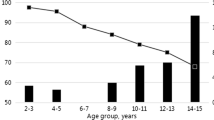Abstract
The seroepidemiology of hepatitis B in children living in Greece 6 years post-implementation of universal infant immunization (1998) was studied. We collected 90–100 sera/year of age, stratified by geographic region. The prevalence of HbsAg(+) was 0.6% (95% CI 0.3–1.3) whereas 4.5% (95% CI 3.4–5.9%) of children over 12 months of age had evidence of past HBV infection. A significant decline in the prevalence of past infection between children born before and after 1998 (5.5% vs 2.9%; RR = 1.9, 95% CI 1.03–3.5) was noted. Conversely, the prevalence of past HBV infection did not change significantly among immigrant children. Reinforcement of early vaccination of immigrant population is necessary.
Similar content being viewed by others
Author information
Authors and Affiliations
Corresponding author
Rights and permissions
About this article
Cite this article
Papaevangelou, V., Hadjichristodoulou, C., Cassimos, D.C. et al. Seroepidemiology of Hepatitis B in Greek Children 6 Years After the Implementation of Universal Vaccination. Infection 36, 135–139 (2008). https://doi.org/10.1007/s15010-007-7096-6
Received:
Accepted:
Published:
Issue Date:
DOI: https://doi.org/10.1007/s15010-007-7096-6




